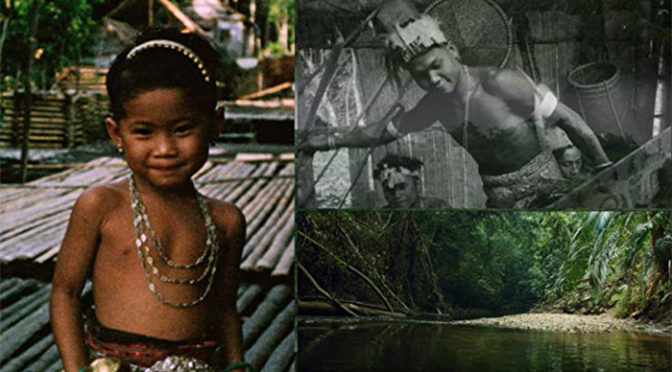In 1959 a young man by the name of Erik Jensen boarded an ocean liner bound for Sarawak on the tropical Island of Borneo. Little did he know he would spend the next seven years living and working with the indigenous Iban people, researching their language and culture. Simultaneously, the traditional way of life for the Iban would come under threat and Erik would end up steering a group of these Iban though times of difficult change, slowly persuading them of the benefits of adaptation.
More than 50 years on, Dan Childs’ excellent documentary takes Erik back to where he lived all those years ago, to find the people he left behind and to discover what has become of them. With wonderful Iban inspired graphics to give context and backstory, Erik guides us through modern Sarawak on an odyssey of rediscovery.
It is clear from the start that the world he knew then has gone. At one point Erik comments that the two or three hour bus journey he is taking from Kuching back to the province of Samanggang would have taken, back then, three days. He reflects that there was only one car then anyway, but that now perhaps we should expect traffic congestion! These questions of change remain throughout the documentary and challenge us to consider the effect of change, both as a source of empowerment and enrichment for the indigenous Iban while reflecting on the consequences of that change on the culture itself.
The film, perfectly paced for its 40 minute running time, explains a great deal of complex social change and the director rightly has one eye on the past with the other firmly on the future. While the environmental impact of change is always there as a subtext, this allows the film space to do two things. Firstly, it displays extraordinary and rarely seen footage of the Iban (much of which Erik shot) as they were just prior to the seismic changes that were about to be imposed on their ancient way of life, footage that captures a moment in history that is, remarkably, a mere two generations ago. It allows the viewer to consider the broader context of the global changes that our planet has undergone in the last half century; extraordinary things to consider.
The second is more subtle but equally compelling. The eye on the future helps us to frame the changes in a positive context. These cultural changes are often heralded with doom and gloom but here the film lets us a see a different narrative, where the grandchildren have real opportunity to follow their dreams (of becoming a doctor, for instance) while being lifted out of real poverty (with the introduction of electricity), while still retaining and remaining interested in much of their cultural heritage (such as traditional dance, weaving and medicine). It is this story, in the context of the last 50 years of global change, that is a rare and welcome cinematic discovery.
Erik remains at the heart of this film and is a large part of what makes it so engaging. He and the director leave you with a lot to consider about the world we live in and what is important to us as individuals. What does success mean, and whose imperative should we believe? Above all the film encourages us to reflect on how we treat others and how we live in society.
At the start, Erik reflects on his time in Sarawak: “As the great English anthropologist Evans-Pritchard once said, ‘it is not the length of the experience but the intensity of the experience that matters’”. A metaphor for the film perhaps, and for us all to consider in our daily lives.
Meet Erik and director Dan Childs at the Cambridge Film Festival screening on Sunday 28th at 17.15 which is followed by KINETICS by Tom Martin.

